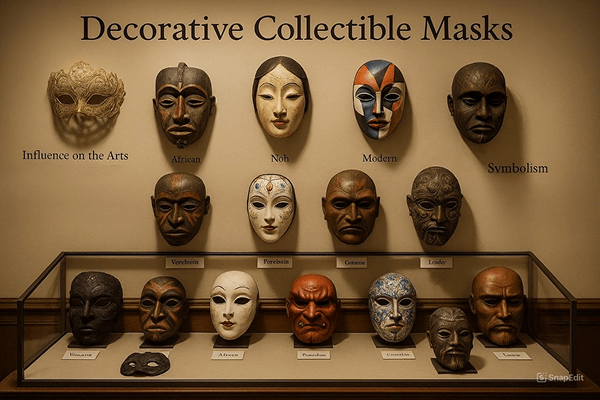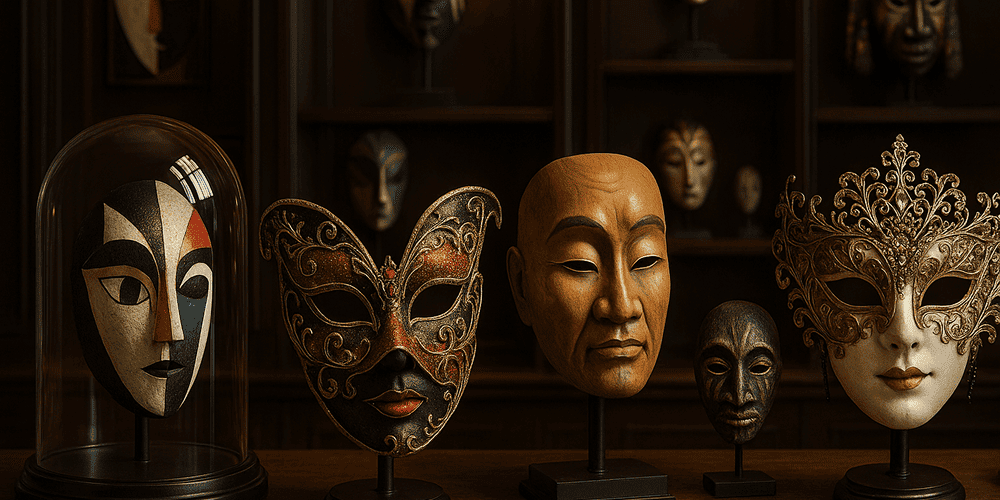Decorative Collectible Masks are extraordinary art objects prized by collectors and enthusiasts for their beauty, craftsmanship, and cultural significance. These masks, which are often displayed in homes, galleries, and museums, feature a stunning array of materials and techniques — from hand-carved wood and painted ceramics to beaded textiles and metalwork. Characterized by intricate details, unique designs, and expressive faces or abstract motifs, Collectible Masks can represent a variety of cultures and historical periods. While some originate from specific rituals or festivals, others are created purely for artistic appreciation. Today, Decorative Collectible Masks are highly sought after by art collectors, interior decorators, and those passionate about global heritage. For a broader perspective, many collectors also explore Wall Masks as a related decorative category. Explore more at toddmasks.com.
Historical Origins of Decorative Collectible Masks
The tradition of collecting masks for display began centuries ago, as explorers, traders, and scholars brought ceremonial and theatrical masks back from distant lands. The word “mask” comes from the Latin “masca,” meaning ghost or spirit, reflecting the mystical origins of masking. In ancient Egypt, Greece, and Rome, masks were used in religious ceremonies, theater, and funerary rites. By the Renaissance and Enlightenment, European collectors amassed masks from Africa, Asia, and the Americas, fascinated by their symbolic and artistic value.
Over time, the function of masks evolved from ritual or performance to objects of aesthetic admiration and scholarly study. The 19th and 20th centuries saw the rise of ethnographic museums and private collections, with significant masks from Benin, Japan, Venice, and Mexico becoming widely known. The collecting tradition continues today, with many artists creating limited-edition or custom Decorative Masks specifically for collectors.
Cultural Significance and Symbolism of Decorative Collectible Masks
Collectible Masks carry deep symbolic meanings, both in their cultures of origin and as objects of admiration. In African cultures, masks symbolize spiritual power, ancestral protection, or social status. In Asia, they may represent deities, mythological beings, or theatrical archetypes. European and Latin American masks often reflect local folklore, carnival traditions, or historical events.
Myths and legends — from African ancestor spirits to Venetian masked balls — are often embedded in mask design. Collecting masks is a way to honor and preserve these stories, fostering appreciation for cultural diversity and artistic heritage. Socially, Collectible Masks can symbolize worldliness, sophistication, or a connection to one’s ancestry.
Materials and Crafting Techniques of Collectible Masks
Decorative Collectible Masks are made from a wide variety of materials, including:
- Wood (carved and painted)
- Ceramics and porcelain
- Papier-mâché and plaster
- Metal (bronze, copper, silver, gold)
- Beads, shells, textiles, leather, glass, and mixed media
The crafting process varies by region and style, but generally involves:
- Designing or sketching the mask
- Carving, molding, or shaping the base material
- Painting, glazing, or applying surface treatments
- Adding decorative elements such as beads, feathers, or metallic leaf
- Mounting the mask for display
Special techniques may include inlay, lacquer, burning, mosaic, and embroidery. Regional differences are notable: African masks are known for bold carving and natural pigments, while Venetian masks use gilding, lace, and vibrant paint. Color symbolism is significant — red for vitality, gold for divinity, black for mystery, and white for purity or the spiritual realm.

Functions and Uses of Decorative Collectible Masks
While many masks are created for ceremonial, theatrical, or festival use, Collectible Masks are typically intended for display. However, their functional roots remain important:
- Ritual and Ceremonial Use: Some collectible masks originate from religious or social rituals and are later retired for display.
- Theatrical Application: Masks used in opera, drama, or dance are often collected after their stage life ends.
- Festival and Holiday Use: Carnival, Halloween, and Day of the Dead masks are popular collectibles.
- Modern Decorative Use: Many masks are made specifically as collector’s items or interior decor, blending traditional motifs with innovative design.
Over time, the purpose of collectible masks has expanded to include personal expression, artistic appreciation, and cultural preservation.
Regional Variations of Decorative Collectible Masks
Collectible Masks showcase global diversity:
- African Masks: Bold wood carvings, geometric patterns, and symbolic motifs.
- Asian Masks: Japanese Noh and Kyogen masks, Chinese opera masks, and Himalayan ritual masks.
- European Masks: Venetian carnival masks, commedia dell’arte, and folk festival masks.
- Latin American Masks: Mexican Day of the Dead, Guatemalan animal masks, and Peruvian festival masks.
- Contemporary and Modern Art Masks: Innovative designs by living artists, often blending global influences.
Each region brings unique techniques, aesthetics, and meanings, making Collectible Masks a window into world cultures. Comparing them to Wall Masks reveals both functional and stylistic overlaps.
Famous Examples and Notable Collections of Collectible Masks
Some of the world’s most renowned Collectible Masks are housed in major museums, such as:
- The Metropolitan Museum of Art (New York)
- Musée du quai Branly (Paris)
- Victoria and Albert Museum (London)
- Smithsonian National Museum of African Art (Washington, D.C.)
- Museo Internacional del Barroco (Puebla, Mexico)
Private collectors and galleries also feature rare, artist-signed, or historically significant masks. Notable artifacts include Benin ivory masks, Venetian carnival masterpieces, and Japanese Noh masks. Digital galleries and expert commentary are available on toddmasks.com, which highlights both historic and contemporary collectible masks.
Influence of Collectible Masks on Art and Culture
Decorative Collectible Masks have profoundly influenced the visual arts, literature, theater, and fashion. Their dramatic forms inspire painters, sculptors, and designers, from Picasso’s African-inspired creations to modern fashion houses referencing mask motifs. In literature and cinema, masks symbolize hidden identity, transformation, and the tension between appearance and reality.
Collectible Masks also play a role in preserving and showcasing global heritage, fostering intercultural dialogue and artistic innovation. Their presence in museum exhibitions, auctions, and design shows highlights their enduring relevance in both traditional and contemporary contexts.

Contemporary Status and Preservation of the Collectible Mask Tradition
Today, the tradition of creating and collecting Decorative Masks is thriving. Master artisans blend traditional techniques with modern materials, including eco-friendly resins, digital fabrication, and hybrid forms. Art schools, museums, and workshops offer mask-making programs and exhibitions.
Innovations include limited-edition artist masks, collaborations with designers, and interactive or augmented reality masks for digital collectors. Online platforms like toddmasks.com support education, curation, and appreciation of collectible mask traditions, ensuring their preservation for future generations.
Collecting and Acquiring Decorative Collectible Masks
The market for Collectible Masks is dynamic, ranging from affordable artisan pieces to high-value museum-quality artifacts. Authentic masks can be found through galleries, museum shops, auctions, and reputable online platforms such as toddmasks.com. Price is influenced by material, craftsmanship, provenance, age, and artist reputation.
Tips for collectors:
- Seek masks with clear documentation and provenance
- Support living artisans and fair-trade initiatives
- Avoid mass-produced or counterfeit items
- Consider ethical aspects, especially for culturally sensitive masks
- Learn about display, preservation, and insurance
Toddmasks.com offers guidance on authentication, valuation, and responsible collecting.
